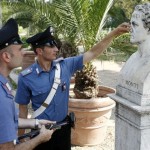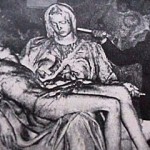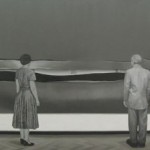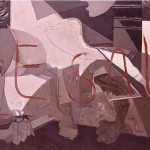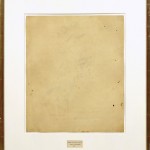Din Heagney picks a few choice examples of artworks that have incited the ire of art fanatics…
The groaning tide of political correctness and conservatism continues to lap against the intellectual shores of the art world, and there have been some eyebrow-raising art crimes breaking the news in recent weeks. But for as long as artists have been making art, there have been people out to destroy it. Whether it’s political regimes with suppressive agendas, mad men with hammers, or just other bad artists driven wild with envy, art has suffered a long and ruinous history at the hands of vandals.
1. Paul Gauguin’s Two Tahitian Women.
On April Fools’ Day this year, a 56-year old woman named Susan Burns walked into the National Gallery of Art in Washington to see the Gauguin: Maker of Myth show. While looking at Two Tahitian Women, she suddenly leapt at it, tried to wrench the painting from the wall, managed to loosen a few screws (and not just from the painting it seems) then began slamming it with her fists yelling that it was evil. After Burns was apprehended by security and arrested she said: “I feel that Gauguin is evil. He has nudity and is bad for the children. He has two women in the painting and it’s very homosexual. I was trying to remove it. I think it should be burned.” While she may know nothing about Tahitian history, at least Burns tried to live up to her name. But it was what she said next that hit the headlines around the world: “I am from the American CIA and I have a radio in my head. I am going to kill you.” Ah yes, another art critic hard at work.
2. The noses on the faces of the statues of the Villa Borghese.
Not to be outdone on delusions of intelligence organisations and their apparently sinister role in ordering art vandalism, another infamous case involved the nose-smashing spree in the Pincio Gardens in the Villa Borghese. Over a number of months in 1985, a mysterious vandal hacked off the noses of more than 80 sculptures including major works by Bernini. It was a shock for police when they discovered the perpetrator was actually a university professor in biology. His rationale became perfectly clear when they discovered a plastic bag full of marble noses he was carrying about with him. He told them: “The KGB are after me.” Then handed them a note that said: “I am a UFO.” Rome has suffered from continuous vandalism, and hacking the faces of famous sculptures seems to be something of a pastime for some, while others simply stole the heads for easy transport to wherever they ended up, usually in some bastard’s private collection. Then there’s the story, which may or may not be true, of a certain Pope who was so offended by the penises on all the handsome sculptures in the Vatican’s Hall of Statues that he ordered them all to be castrated and replaced with fig leaves, a la the Garden of Eden. It was alluded to in the Angels and Demons movie, but the Vatican has denied the charge, apparently because those particular anatomical parts are attached later, so the male members easily fall off. A little like Australian politics of late.
3. Michelangelo Buonarroti’s La Pietà.
While on the topic of Rome’s sculpture and noses, there is possibly no more infamous case of art vandalism that the Hungarian-Australian geologist Laszlo Toth. On Pentecost Sunday in 1972, Toth entered St Peter’s Basilica, along with hoards of worshipers and camera happy tourists. He then pulled out a geologist’s hammer and began to smash La Pietà, the most famous of Michelangelo’s works and certainly one of the most revered sculptures in the world. As pieces of marble flew around the Basilica, tourists snatched the fragments up and ran off with them (and we know where those people will be going now don’t we). While Toth whacked the 500-year old sculpture fifteen times he yelled: “I am Jesus Christ, risen from the dead!” Before being subdued by security, Toth managed to chip Mary’s nose and eyelid, as well as smashing off her forearm, the fingers breaking when the arm hit the marble floor. The restorers did some fancy plastic surgery, removing a small amount of marble from her back to replace her nose and fix the other dents left by Toth’s hammer. He was subdued by the crowd and later served time in a mental institution before being deported back to Australia. There are various stories that Toth spent years in the Australian outback where he says he encountered beings from another dimension that told him the secrets of the Vatican. Aliens and God seem to have some common link here in inspiring vandals.
4. Murujuga’s Philomena.
From outback aliens to outback vandals, this year Greens politician Robin Chapple caused a ruckus after he visited the Burrup Peninsula in far north Western Australia. To his horror he discovered someone had scrawled the name “Philomena” onto the rocks in Murujuga, considered to be one of the world’s most important collections of petroglyphs, which by the way do not mark where to start drilling (Rio Tinto and Friends: I’m talking to you). For decades there has been a long debate with local mining interests over the region. Since then, the World Monuments Fund and the National Trust have stepped in to protect the rock art that includes more than a million images, many more than 10,000 years old. So while Murujuga was heritage listed in 2007 that did not stop the willful Philomena from desecrating the ancient rock faces. Chapple started up a campaign in Parliament for greater heritage protection, which fortunately worked. What I don’t get about this story is that the graffiti was supposedly only a week old when discovered, but who is even called Philomena any more? Sure, it was once a popular name, like in 1915. Then there was that cult that started in Europe after the bones of a supposed virgin saint were unearthed in Rome in 1802, but archeologists gave the thumbs down on their authenticity in 1961 and the Catholic Church banned the worship of Philomena, so I’m pretty sure it’s not a Christian neophyte run a muck in the Top End. Maybe it wasn’t vandalism at all, maybe it was just someone’s grandmother who came up with some of her mob from a nearby community and decided to sign one of her early works?
5. Barnett Newman’s Who’s Afraid of Red, Yellow and Blue (III and IV).
Who’s afraid of Barnett Newman’s primary colourfield works? Well a couple of guys in particular who went on rampages against the minimalist paintings, so it’s probably a good thing he made a few of them. In 1982, Who’s Afraid of Red, Yellow and Blue IV was on display at the Nationalgalerie in Berlin when Josef Nikolaus Kleer, a 29-year old veterinary student, staged a rather complex attack on the work. He first used a security barrier to whack the painting a few times before placing a series of notes and media pictures on and around it that said things like: “Whoever does not yet understand it must pay for it! Price: on arrangement.” When Kleer later admitted to the attack, he said it was because the painting was a perversion of the German flag and that public funds should not be used to buy art because artists earned too much money. They were really some delusions, but Kleer also said he had “completed” the work, an argument used by a number of art vandals over the years. A few years later in 1986, Gerard Jan van Bladeren would use the same defense after he attacked Who’s Afraid of Red, Yellow and Blue III at the Stedelijk Museum in Amsterdam, slashing the entire canvas repeatedly with a Stanley knife. In court, van Bladeren said he slashed the painting because he was a fan of magic realism. Okay… He then read a long art criticism essay, which didn’t help his case much, nor did his sentence prevent him from attacking another Newman painting in 1997. Obsessed much?
6. Pablo Picasso’s Guernica.
In 1974, Tony Shafrazi, then a 30 year-old artist in New York City, visited the Museum of Modern Art where he staged a solo protest by spray-painting the words “KILL LIES ALL” across Picasso’s famous painting about the indictment of war. He then shouted for the curator yelling: “I am an artist!” Perhaps luckily for him, the museum easily cleaned the spray paint off the thick varnish (painters take note) and Shafrazi escaped with a five-year probation. Apparently the attack was politically motivated in response to the release and pardon by President Nixon of a soldier who was up on charges of war crimes in the My Lai Massacre during the Vietnam War. In any case, when asked by the judge if Shafrazi would promise to never do it again, he replied: “It would be crazy to repeat an act like that.” When the judge asked why, he replied: “Because it had been done.” Interestingly enough, Shafrazi not only went on to become a successful New York art dealer, selling work from artists like Keith Haring and David LaChapelle, he was also an art consultant to the Shah of Iran, helping him and his wife build a modern art collection worth billions.
7. Robert Rauschenberg’s Erased de Kooning.
Perhaps not quite a case of vandalism, Robert Rauschenberg’s famous erasure of a Willem de Kooning drawing was a well planned attempt to incorporate the more famous de Kooning into his own oeuvre. In 1953, the young Rauschenberg was looking to a form of ‘all white’ drawing style, and he would erase his own drawings. Being dissatisfied, he sought out a more significant piece of art and so decided to pay de Kooning a personal visit, armed with a bottle of Jack Daniels. After a while chatting, he asked de Kooning for one of his drawings, and then explained why. He was surprised when de Kooning said he knew what Rauschenberg was up to, then not only agreed to give him a drawing to erase but also said: “I want it to be something I’ll miss, and I will give you something really difficult to erase,” then proceeded to slowly page through his various folios. The piece that de Kooning gave Rauschenberg featured charcoal, oil paint, pencil and crayon, which took him more than a month to erase. When exhibited it caused a scandal, with people decrying the destruction of a modern masterpiece, others pointed to the Oedipal nuances of the younger artist erasing the master, symbolically killing the father. Apparently de Kooning wasn’t too pleased that it was shown publicly and thought it should have remained private. While media and critics called it blatant vandalism and anti-abstract expressionism, Rauschenberg simply called it poetry.
8. Andres Serrano’s Piss Christ.
This crucifix suspended in the artist’s pee has caused controversy since it was first awarded a prize in a competition funded by the National Endowment for the Arts in the USA. The drama started when religious groups in the United States used Serrano’s work to campaign against the NEA, which in turn led to a senator tearing up a photograph of the actual photograph. The debacle soon turned into a bitter and ongoing national debate that has seen the NEA slowly eroded, even though it represents about 0.0045 percent of the total US federal budget. Many Australians will remember the hoo-hah around the Serrano retrospective at the National Gallery of Victoria in 1997. This got the goat of the Catholic Church, which tried unsuccessfully to get a Supreme Court injunction to stop the show on the grounds that the work was blasphemous. The show went ahead, then on the first day someone tried to steal the piece but was thwarted. The next day while the NGV staff wondered whether to take seriously the death threats that were pouring in, a 16-year old boy and a 51-year old man distracted the guards then went at the work with a hammer. The drama that ensued not only dragged in Serrano, but the Premier, the Archbishop, the NGV Director, and a swathe of public who all suddenly became art experts. The show was cancelled, and yet another international artist left town wondering why they bothered coming such a long way. The latest attack on Piss Christ came just a couple of weeks ago at the Collection Lambert in Avignon, France, when three right-wing religious aficionados snuck in with a hammer and an ice pick and began to hack away at the print, shattering the glass and leaving a gash, somewhat ironically, across the face of Jesus.
9. Cy Twombly’s Phaedrus.
Speaking of Avignon, the original home to those twisted whores in Picasso’s famous painting, there was another recent case of vandalism in the town, and in this instance it was a French artist who vandalized the work of the American artist Cy Twombly …sacrebleu l’horreur! In 2007, French-Cambodian artist Rindy Sam was so overcome by Twombly’s all-white Phaedrus that she kissed it, leaving red lipstick smeared across the multi-million dollar canvas. After she was arrested, Sam said it was part of her own art practice: “I left a kiss, a red stain remained on the canvas. This red stain is testimony to this moment, to the power of art. Twombly has left this white for me.” She then apparently went home and ticked it off her list of lifetime achievements. I wonder if being charged with a criminal act was one of them?
Appearing in court later on, Sam said she thought the artist would understand her “act of love”. “It was just a kiss, a loving gesture,” Sam told the courtroom, “It was an artistic act provoked by the power of art.” Needless to say, no one was particularly impressed and Twombly only said he was horrified. The prosecution called her act “a sort of cannibalism, or parasitism” while the court said it was “voluntary degradation of a work of art”. The court ordered Sam to pay a fine of 1,000€ to the painting’s owner, 500€ to the Avignon gallery that showed it, and 1€ to the painter. It seems that even in criminal proceedings over works worth millions that the artist still finishes last, with barely a buck to show for it in the end.
10. Conservation, Preservation, Restoration or Decay?
The argument for restoration versus conservation of art is one that has raged for centuries. In the meantime, innumerable priceless works have been ruined by the ravaging chemical peels to remove stained glazes and faded colours, while restorers took it upon themselves to ‘touch up’ and repaint sections of entire works, destroying the integrity of the original. From the Sistine Chapel in Rome to the Metropolitan Museum in New York to the National Gallery in London, famous art works have been given innumerable facelifts in recent decades that many critics consider a form of vandalism. Suzanne Sulzberger, art professor at the University of Brussels once commented: “I can only compare restoration to plastic surgery for women. Wrinkles and other signs of age may disappear, but the overall impression is one of artificiality, of untruthfulness.” Others defend the techniques of conservation, like the former chief restorer at the Tate Gallery said: “So many people are involved and so many tests are done that it is practically impossible to damage something. A mass of chemical equipment is used, every picture is scrupulously documented, and proof positive is needed for what is done.” Personally I fall on the preservation side of the argument, not being a fan of restoration or conservation much, I believe art should be protected but not remade to its original form. Like all things in our imperfect world, I believe that aging and decay are in themselves beautiful expressions of life. When I see the work of a master artist from centuries ago, I want to see the peeling canvas, the cracked glazes, the faded tones; these things remind me that I am looking at the hand made work of another person from another time. If some nutter with a hammer smashed off the nose of a sculpture I would prefer to see that than one glued back on, for it would make it all the more poignant, and reveal the truly fleeting and ephemeral nature of the things we create. Art should not exist in a vacuum, nor should it be sealed off from time. In this sense, perhaps the art of life is more important than the life of art.

